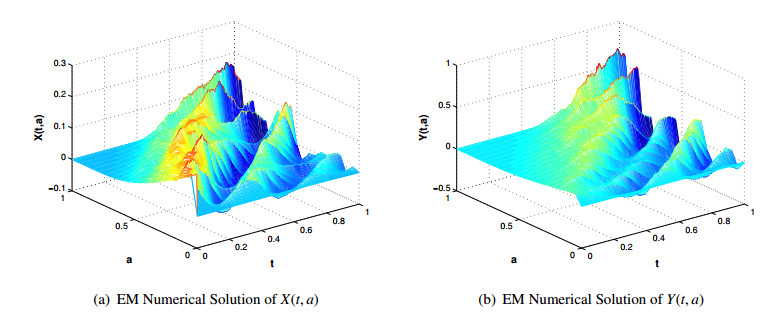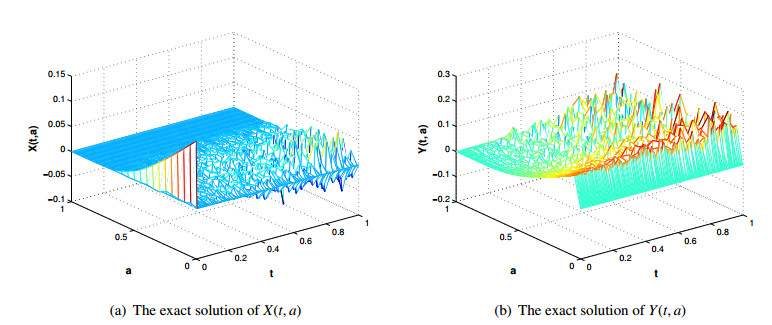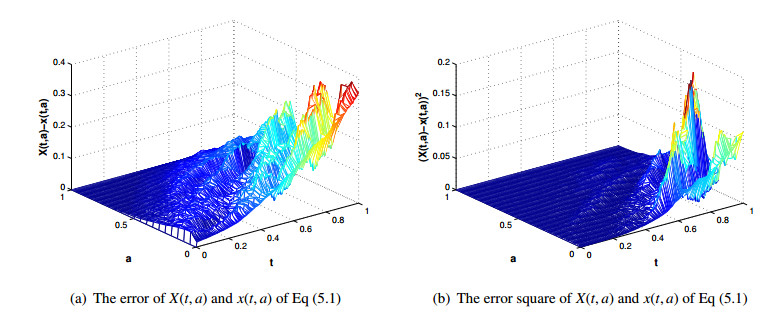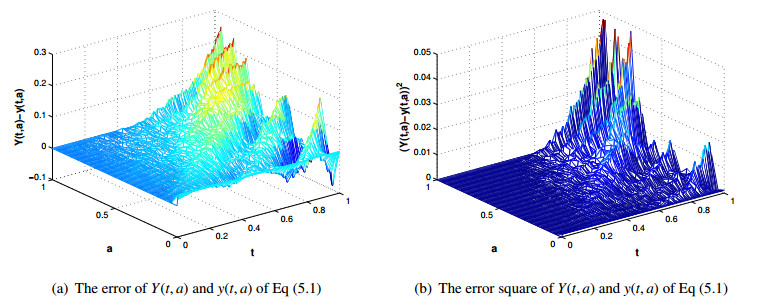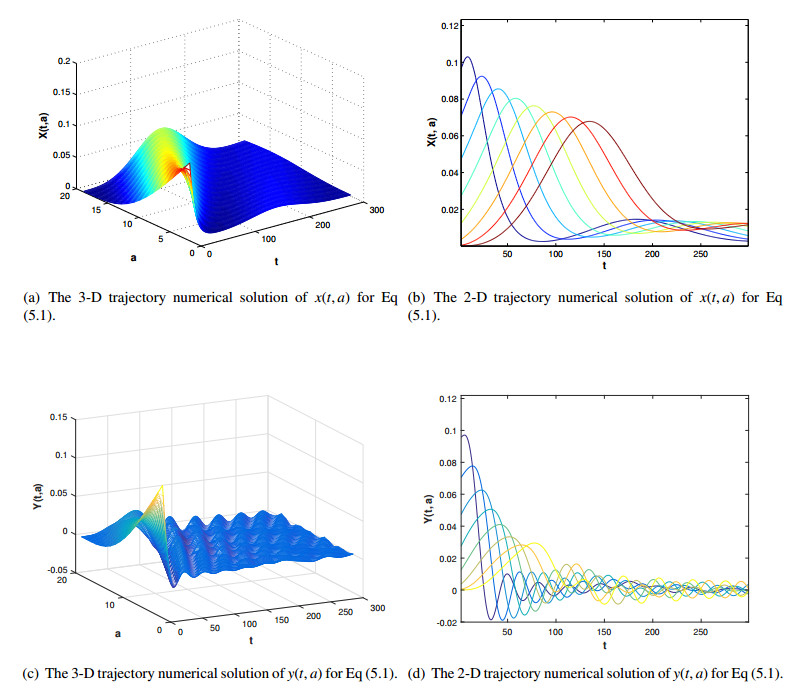1.
Introduction
Mathematical models have been used to understand and control the dynamics of the disease (influenza, covid 19, HIV etc.). After first SIR type mathematical model constructed by Karmic and MC-Kendrick, for different kind of models (SIR, SIS, SEIR, SI etc.) have been proposed and studied by many authors (see, e.g., [1,2,3,4]). One of the important virus that whole world fighting with is the Human Immunodeficiency Virus (HIV) that is a lent virus caused HIV infection [5]. HIV virus can be transmitted in many ways like sexual intercourse, direct contact with contaminated blood products, needle, or during birth or through breastfeeding (mother to child). Since there is no recovery after HIV, SI type models are more appropriate to comprehend the dynamics of the HIV. In [3], J.J.Wang et al. have been studied mother to child transmission of HIV. The system that obtained with the constructed model in [3] extended and the numerical solutions of the system of linear parabolic equations(PEs) is studied in [6]. In the paper [7], Ashyralyev, Hincal and Kaymakamzade investigated the boundedness of solution of the initial boundary value problem for the system of PEs of observing epidemic models with general nonlinear incidence rate. This model constructed in [8] and it is well-known that (see, [9]) such and many other initial boundary value problems for system of PEs can be reduced to the initial-value problem for system of ordinary differential equations
in a Hilbert.space.H.with a self-adjoint.positive.definite.operator A≥δI,δ>0.
Existence.and.uniqueness.theorems.of the.bounded.solution of linear and nonlinear systems was.established in the following theorem ([7], [9]).
Theorem 1. Assume.the following.hypotheses hold
1. ψn,1≤n≤3 belongs to D(A) and
2. The.function.F:[0,T]×H×H⟶H be.continuous.function, that.is
in [0,T]×H×H and Lipschitz condition holds uniformly with respect to t
3. The.function.G:[0,T]×H⟶H be.continuous function, that is
in [0,T]×H and Lipschitz condition holds uniformly with respect to t
Then, there.exists.a unique bounded solution v(t)=(v1(t),v2(t),v3(t))⊥ of problem (1.1).
In applications, theorems on the bounded solutions of several systems of nonlinear. PEs were given. Moreover the first order of accuracy DS
for the approximate solution of problem (1.1) was studied. The existence and uniqueness of a bounded solution of DS (1.7) uniformly with.respect.to time.step.τ was.established in the following theorem.
Theorem 2. If the assumptions (1.2)-(1.6) and μ+δ>2(L1+L2) hold, then there exists a unique solution vτ={vk}Nk=0 of DS (1.7) which is bounded uniformly with respect to τ.
Bounded solutions of several systems of nonlinear PEs and DSs for the approximate solution of these systems were constituted. Numerical results were provided.
In general, .it is not possible to get exact solution of nonlinear problems. Therefore, we are interested in constructing a uniformly bounded high order of accuracy DSs with respect to time step size for the approximate solutions initial value problem (1.1).
In this work, for the approximate solution.of problem (1.1), the second.order of accuracy.Crank-Nicholson DS is investigated. The existence and uniqueness theorems of bounded solution of Crank-Nicholson DS uniformly with respect to time step τ is proved. In practice, theoretical results are presented on four nonlinear systems of parabolic equations to explain how it works on one and multidimensional problems. Numerical results are provided.
2.
The main theorem on uniformly boundedness
In this section, it will be considered the second order of accuracy Crank-Nicholson DS
for the approximate solution.of the initial.value.problem (1.1).
It is interested to studied the existence and uniqueness of a bounded solution of Crank- Nicholson DS (2.1) uniformly with respect to time step τ under the assumptions of Theorem 2.
Unfortunately, we are not able to establish the Theorem 3 for the solution of Crank-Nicholson DS (2.1) under the assumption μ+δ>2(L1+L2) without restriction to T. Nevertheless, it could be established the such result under assumption 1+1/2τ(μ+δ)>2(L1+L2)T. It is more strong than μ+δ>2(L1+L2) that means it is under assumption with restriction for T. Thus such result we can proved under assumption with restriction for T. It is based on reducing this DS to an equivalent system of nonlinear equations and is used as an operator method to prove the main theorem on the existence and uniqueness of a bounded solution of DS (2.1) uniformly with respect to τ.
An equivalent system of nonlinear equations for the DS (2.1) is
in Cτ(H)×Cτ(H)×Cτ(H) and the using of successive approximations. Here.and.in.future B=(I−τ(μI+A)2)R,R=(I+τ(μI+A)2)−1,B1=(I−τ((μ+α)I+A)2)R1,R1=(I+τ((μ+α)I+A)2)−1 and Cτ(H)=C([0,T]τ,H) stands for the Banach space of the mesh functions vτ={vl}Nl=0 defined on [0,T]τ with values in H,equipped with the norm
For the solution of DS (2.1), the recursive formula is
From (2.2) and (2.3) it follows
Theorem 3. Let the assumptions (1.2)-(1.6) be satisfied and 2(L1+L2)T<1+τ(μ+δ)2. Then, there exists a unique solution vτ={vk}Nk=0 of DS (2.1) that is bounded in Cτ(H)×Cτ(H)×Cτ(H) of uniformly wrt. τ.
Proof. Since v3k does not appear in equations for vnk−vnk−1τ,n=1,2, it is sufficient to analyze the behaviors of solutions v1k and v2k of (2.1). According to the method of recursive approximation (2.4), we get
where
Applying formula (2.6), estimates
we get
Applying formula (2.4), estimates (2.7) and
we get
for any k=1,⋅⋅⋅,N. With using triangle inequality, is is obtained that
for any.k=1,⋅⋅⋅,N. Applying.formula (2.4), and estimates (2.7), (2.9), (1.4), (1.2) and (1.3), we get
for any k=1,⋅⋅⋅,N. Then
for any k=1,⋅⋅⋅,N. Let
Applying formula (2.4), estimates (2.7), (1.4), (1.2) and (1.3), we get
for any k=1,⋅⋅⋅,N. Then
for any k=1,⋅⋅⋅,N. Therefore, for any j,j≥1, we have that
and
by mathematical.induction. From that and formula (2.5) it is obtained
that proves the existence of a bounded solution of DS (2.1) which is bounded.in Cτ(H)×Cτ(H)×Cτ(H) of uniformly wrt. τ. Theorem 3 is proved.
A study of discretization, over time only, of the initial value problem also permits one to include general DSs in applications, if the differential operator A is replaced by the difference operator Ah that act in the Hilbert spaces and are uniformly self-adjoint positive definite in h for 0<h≤h0.
3.
Applications
In this section it will be given considered some nonlinear partial differential equations(PDEs).
First, we consider the initial-boundary.value problem for one.dimensional system.of nonlinear PDEs.
where a(x),ψ(x) are given sufficiently smooth functions and δ>0 is the sufficiently large number. We will assume that a(x)≥a>0 and a(l)=a(0).
Assume the following.hypotheses hold
1. ψn,n=1,2,3 belongs to W22[0,l] and
2. The function f:[0,T]×[0,l]×L2[0,l]×L2[0,l]→L2[0,l] be continuous function in t, that is
in [0,T]×[0,l]×L2[0,l]×L2[0,l] and Lipschitz condition holds uniformly with respect to t
3. The function g:[0,T]×[0,l]×L2[0,l]→L2[0,l] be continuous function in t, that is
in [0,T]×[0,l]×L2[0,l] and Lipschitz condition holds uniformly with respect to t
Here and in future, Lm,m=1,2,Mm,m=1,2,3 are positive constants.
The discretization of problem (3.1) is carried out in two steps. In the first step, let us define the grid space
We introduce the Hilbert spaces L2h=L2([0,l]h) and W22h=W22([0,l]h)\ of the grid functions ψh(x)={ψr}K0 defined on [0,l]h, equipped with the norms
and
respectively. To the differential operator A generated by problem (3.1), we assign the difference operator Axh by the formula
acting in the space of grid functions ψh(x)={ψr}K0 satisfying the conditions ψ0=ψK, ψ1−ψ0=ψK−ψK−1. With the help of Axh, we arrive at the initial value problem
for an infinite system of nonlinear ordinary differential equations (ODEs). In the second step, we replace problem (3.8) by DS (2.1)
Theorem 4. Let the assumptions (3.2)-(3.6) be satisfied and 2(L1+L2)T<1+τ(μ+δ)2. Then, there exists a unique solution vτ={vk}Nk=0 of DS (3.9) which is bounded in Cτ(L2h)×Cτ(L2h)×Cτ(L2h) of uniformly with respect to τ and h.
The proof of Theorem 4 is based on the abstract Theorem 3 and symmetry properties of the difference operator Axh defined by formula (3.7)[11].
Second, we consider the initial-boundary value problem for one dimensional system of nonlinear PDs with involution
where a(x),ψ(x) are given sufficiently smooth functions and δ>0 is the sufficiently large number. We will assume that a≥a(x)=a(−x)≥δ>0,δ−a|β|≥0.
Assume the following hypotheses:
1. ψn,n=1,2,3 belongs to W22[−l,l] and
2. The function F:[0,T]×[−l,l]×L2[−l,l]×L2[−l,l]→L2[−l,l] be continuous function in t, that is
in [0,T]×[−l,l]×L2[−l,l]×L2[−l,l] and Lipschitz condition holds uniformly with respect to t
3. The function G:[0,T]×[−l,l]×L2[−l,l]→L2[−l,l] be continuous function in t, that is
in [0,T]×[−l,l]×L2[−l,l] and Lipschitz condition holds uniformly with respect to t
The discretization of problem (3.10) is carried out in two steps. In the first step, let us define the grid space
We introduce the Hilbert spaces L2h=L2([−l,l]h) and W22h=W22([−l,l]h)\ of the grid functions ψh(x)={ψr}K−K defined on [−l,l]h, equipped with the norms
and
respectively. To the differential operator A generated by problem (3.10), we assign the difference operator Axh by the formula
acting in the space of grid functions ψh(x)={ψr}K−K satisfying the conditions ψ−K=ψK=0. With the help of Axh, we arrive at the initial value problem
for an infinite system of nonlinear ODEs. In the second step, we replace problem (3.17) by DS (2.1)
Theorem 5. Let the assumptions (3.11)-(3.15) be satisfied and 2(L1+L2)T<1+τ(μ+δ)2. Then, there exists a unique solution vτ={vk}Nk=0 of DS (3.18) which is bounded in Cτ(L2h)×Cτ(L2h)×Cτ(L2h) of uniformly with respect to τ and h.
The proof of Theorem 5 is based on the abstract Theorem 3 and symmetry properties of the difference operator Axh defined by formula (3.16)[12].
Third, let Ω⊂Rn be a bounded open domain with smooth boundary S, ¯Ω=Ω∪S. In [0,T]×Ω we consider the initial-boundary value problem for multidimensional system of nonlinear PDEs
where ar(x) and ψm(x) are given sufficiently smooth functions and δ>0 is the sufficiently large number and ar(x)>0.
Assume the following hypotheses:
1. ψm,m=1,2,3 belongs to L2(¯Ω) and
2. The function f:[0,T]×[0,l]×L2(¯Ω)×L2(¯Ω)→L2(¯Ω) be continuous function in t, that is
in [0,T]×[0,l]×L2(¯Ω)×L2(¯Ω) and Lipschitz condition holds uniformly with respect to t
3. The function G:[0,T]×[0,l]×L2(¯Ω)→L2(¯Ω) be continuous function in t, that is
in [0,T]×[0,l]×L2(¯Ω) and Lipschitz condition holds uniformly with respect to t
The discretization of problem (3.19) is also carried out in two steps. In the first step, let us define the grid sets
We introduce the Banach spaces L2h=L2(¯Ωh) and W22h=W22(¯Ωh)\ of the grid functions φh(x)={ψ(h1r1,...,hmrm)} defined on ¯Ωh, equipped with the norms
and
respectively. To the differential operator A generated by problem (3.19), we assign the difference operator Axh by the formula
acting in the space of grid functions uh(x), satisfying the conditions vh(x)=0 for all x∈Sh. It is known that Axh is a self-adjoint positive definite operator in L2(¯Ωh). With the help of Axh, we arrive at the initial value problem
for an infinite system of nonlinear ODEs. In the second step, we replace problem (3.26) by DS (2.1)
Theorem 6. Let the assumptions (3.20)-(3.24) be satisfied and 2(L1+L2)T<1+τ(μ+δ)2. Then, there exists a unique solution vτ={vk}Nk=0 of DS (3.27) which is bounded in Cτ(L2h)×Cτ(L2h)×Cτ(L2h) of uniformly with respect to τ and h.
The proof of Theorem 6 is based on the abstract Theorem 4 and symmetry properties of the difference operator Axh defined by formula (3.25) and the following theorem on coercivity inequality for the solution of the elliptic problem in L2h.
Theorem 7. For the solutions of the elliptic difference problem
the following coercivity inequality
holds (see [13]).
Fourth, in [0,T]×Ω we consider the initial-boundary value problem for multidimensional system of nonlinear PDEs
where ar(x) and ψm(x) are given sufficiently smooth functions and δ>0 is the sufficiently large number and ar(x)>0. Here, →p is the normal vector to Ω.
The discretization of problem (3.28) is also carried out in two steps. In the first step, to the differential operator A generated by problem (3.28), we assign the difference operator Axh by the formula
acting in the space of grid functions vh(x), satisfying the conditions Dhvh(x)=0 for all x∈Sh. Here Dh is the approximation of operator ∂∂→p. It is known that Axh is a self-adjoint positive definite operator in L2(¯Ωh). With the help of Axh, we arrive at the initial value problem (3.26) for an infinite system of nonlinear ODEs. In the second step, we replace problem (3.26) by DS (2.1), we get DS (3.27).
Theorem 8. Let the assumptions (3.20)-(3.24) be satisfied and 2(L1+L2)T<1+τ(μ+δ)2. Then, there exists a unique solution vτ={vk}Nk=0 of DS (3.27) which is bounded in Cτ(L2h)×Cτ(L2h)×Cτ(L2h) of uniformly with respect to τ and h.
The proof of Theorem 8 is based on the abstract Theorem 3 and symmetry properties of the difference operator Axh defined by formula (3.29) and the following theorem on coercivity inequality for the solution of the elliptic problem in L2h.
Theorem 9. For the solutions of the elliptic difference problem
the following coercivity inequality holds (see [13]):
4.
Numerical results
In present section, we consider the initial-boundary value problem
for the system of nonlinear PDEs. The spatial factor, x, can be spatially discrete or spatially continuous. In either case, the spatial factor is used to describe the mobility of the population. This mobility can be due to travel and migration, and it could be between cities, towns or even countries, depending on the studied case. The exact solution of problem (4.1) is vm(t,x)=e−tsinx,m=1,2,3.
Numerical solutions of system (4.1) will be given for first and second order of DS. Firstly, we consider the first order of accuracy iterative DS
and secondly, the second order of accuracy iterative Crank-Nicholson DS
for the.approximate solution of the.initial-boundary.value.problem (4.1) for the system.of nonlinear. PEs. Here and in future j denotes the iteration.index and an.initial guess. _{0}u_{n}^{k}, k\geq 1, 0\leq n\leq M is to be made. For solving DS (4.3), the numerical.steps are.given.below. For 0\leq k < N, 0\leq n\leq M the algorithm.is as follows.[10] :
1. j = 1 .
2. _{j-1}v_{n}^{k} is.known.
3. _{j}v_{n}^{k} is.calculated.
4. If the.max absolute.error between _{j-1}v_{n}^{k} and _{j}v_{n}^{k} is greater.than the given.tolerance value \varepsilon = 10^{-8} , take j = j+1 and go.to.step 2. Otherwise, terminate.the iteration.process and take _{j}v_{n}^{k} as the result of the given problem. The errors are computed by
of the numerical solutions, where v^{m}(t_{k}, x_{n}) \;, m = 1, 2, 3 represents the exact solutions and \left(jv^{m}\right) _{n}^{k} \;, m = 1, 2, 3 represents.the numerical.solutions at (t_{k}, x_{n}) and the results of the first and second order of DS are given.in Table 1 and Table 2 respectively.
According to Table 1 and Table 2, if N and M are doubled, the value of errors in the first order of accuracy DS decrease by a factor of 1/2, the errors in the second order of accuracy DS (4.3) decrease approximately by a factor of 1/4 . The errors presented in the tables indicate the stability of the DS and the accuracy of the results. Thus, the second order of accuracy DS increases faster than the first order of accuracy DS.
5.
Conclusion
In the present paper, the.initial boundary value problem for the nonlinear system of PEs observing epidemic models with general nonlinear incidence rate is investigated. The main theorem on the existence and uniqueness of a bounded solution of Crank-Nicholson DS uniformly with respect to time step \tau is established. Applications of the theoretical results are presented for the four systems of one and multidimensional problems with different boundary conditions. Numerical results are given.
Acknowledgments
The publication has been prepared with the support of the "RUDN University Program 5-100" and published under target program BR05236656 of the Science Committee of the Ministry of Education and Science of the Republic of Kazakhstan.
Conflict of interest
The author declares that there are no conflicts of interest.









 DownLoad:
DownLoad:


